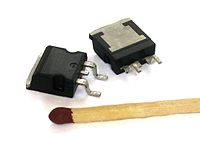
Photo from wikipedia
The fundamental mode characteristics of hybrid metal‐insulator‐metal plasmonic waveguide (HMIMPW), consists of a high‐index layer sandwiched between two spacer/low‐index and metal layers, has been explored to achieve relatively high power… Click to show full abstract
The fundamental mode characteristics of hybrid metal‐insulator‐metal plasmonic waveguide (HMIMPW), consists of a high‐index layer sandwiched between two spacer/low‐index and metal layers, has been explored to achieve relatively high power density with smaller effective mode area in low‐index waveguide region at the wavelength of 1550 nm. The HMIMPW has the advantage of low power loss with relatively large propagation distance, of order of several tens of λ. The simulation results have demonstrated that with spacer thickness of 10 nm, significantly higher confinement of optical mode power (> 65%) can be realized in the spacer region of HMIMPW with relatively smaller effective area of 0.0060 μm2 together with the power density > 200 μm−2. This type of analysis and results are very desirable for several specific applications, like optical sensing, nonlinear optics, optical manipulations. Further, the investigations on crosstalk performance between two parallel HMIMPWs have been addressed in order to realize the high integration density over the photonic chip. The decoupling separation of nearly 560 nm has been accomplished with the thicknesses of low‐ and high‐index regions, respectively, of 10 and 50 nm.
Journal Title: Microwave and Optical Technology Letters
Year Published: 2020
Link to full text (if available)
Share on Social Media: Sign Up to like & get
recommendations!